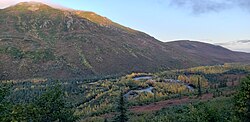| Moose Creek | |
|---|---|
 | |
 | |
| Location | |
| Country | United States |
| State | Alaska |
| Physical characteristics | |
| Mouth | Bearpaw River |
• location | Diamond, Alaska, United States |
• coordinates | 63°53′18″N150°54′14″W / 63.8883333°N 150.9038889°W [1] |
• elevation | 548 ft (167 m) |
| Basin features | |
| Tributaries | |
| • left | Lake Creek |
Moose Creek heads in Denali National Park and Preserve and is a tributary of the Bearpaw River in central Alaska. Wonder Lake drains into Moose Creek. Variant names include Hutenaal'eey No' and Hutenaal'eeyh No' Hutl'ot. [1]